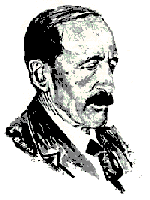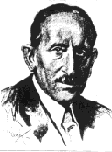About James Ewing, 1866 - 1943


 About Ewing's sarcoma
About Ewing's sarcoma
 James Ewing - Childhood, education, and early career
James Ewing - Childhood, education, and early career
 James Ewing - Cancer Pathologist, 'The Chief'
James Ewing - Cancer Pathologist, 'The Chief'
 References
References
Ewing first described the tumour as an "endothelioma of bone" believing that it arose from the blood vessels of bone tissue. He later recognised that the histopathologic features were more complex and went on to describe it as a "endothelial myeloma". He described the histopathology as "broad sheets of small polyhedral cells with pale cytoplasm, small hyperchromatic nuclei, well-defined cell borders and complete absence of inter-cellular material". Reports of similar tumours were made in earlier literature (Lucke, 1866; Hildebrand, 1890), but it was the work of Ewing which established that the disease was separate from lymphoma or neuroblastoma [5]. Today it is known that Ewing's sarcoma covers a spectrum ranging from classical Ewing's to those tumours which are positive for neural markers (Peripheral Neuroectodermal Tumours). This range of tumours all share the same genetic features, namely a t(11;22) translocation [6]. Today the origin of Ewing's Tumour still remains unclear.
 Go to InterNet resources for bone cancer
Go to InterNet resources for bone cancer
After briefly working at the Western Pennsylvania Hospital Ewing returned to New York and was given a prestigious internship at the Roosevelt Hospital and Sloane Maternity. He spent much of this time in the hospital laboratory and developed a keen interest in pathology. In 1898 Ewing volunteered as contract surgeon to the US army, treating soldiers evacuated from Cuba and Manila. He published several papers on malaria from which many of the soldiers suffered [7, 8].
In 1899 Ewing was appointed as the first Professor of Pathology at Cornell University, a position which he kept for 33 years. His first book Clinical Pathology of blood was published in 1901. In mid 1900 he married Catherine Halsted and his son James was born two years later, sadly his wife and unborn second child died in 1903.
Ewing had a growing interest in tumours, and was instrumental in establishing the P. Huntington Fund for Cancer Research in 1902. Linked with this he became a leading cancer pathologist and was a prolific in writing papers about cancer. Ewing was a co-founder of the American Association for Cancer Research in 1907. This brought him into contact with James Douglas who was a mining engineer but with a medical background. Douglas had an interest in the possible therapeutic potential of radium and went on to found the National Radium Institute in 1913. In the same year Ewing co-founded the American Society for the Control of Cancer (now the American Cancer Society). The friendship between Douglas and Ewing grew, and Ewing became one of the pioneers in using radiotherapy for cancer [7, 8].
After many years work Ewing's successful textbook Neoplastic Diseases was published in 1919. The following year at a meeting of the New York Pathological Society Ewing presented his paper on the malignant bone tumour that was later became known as Ewing's sarcoma. Ewing was one of the first to recognise the potential of radiation as cancer therapy, stating in 1922; 'From the most unexpected source, experimental physics, a new and powerful weapon has been brought into play'. He also had a role in the development of surgical oncology by encouraging surgeons to gain a better understanding of the natural course of cancer. Ewing laid the foundations of what is now known as the Memorial Sloan-Kettering Cancer Centre, building up a strong team of physicians who later distinguished themselves in the various specialities in oncology. His reputation was widespread, his peers referred to him as "The Chief" and "Mr Cancer" [7].

James Ewing died from bladder cancer at the age of 76. He had a large influence in the development of oncology, over a thousand people attended his last rites in 1943.
First created: 04/06/96
Last modified: 16/03/99